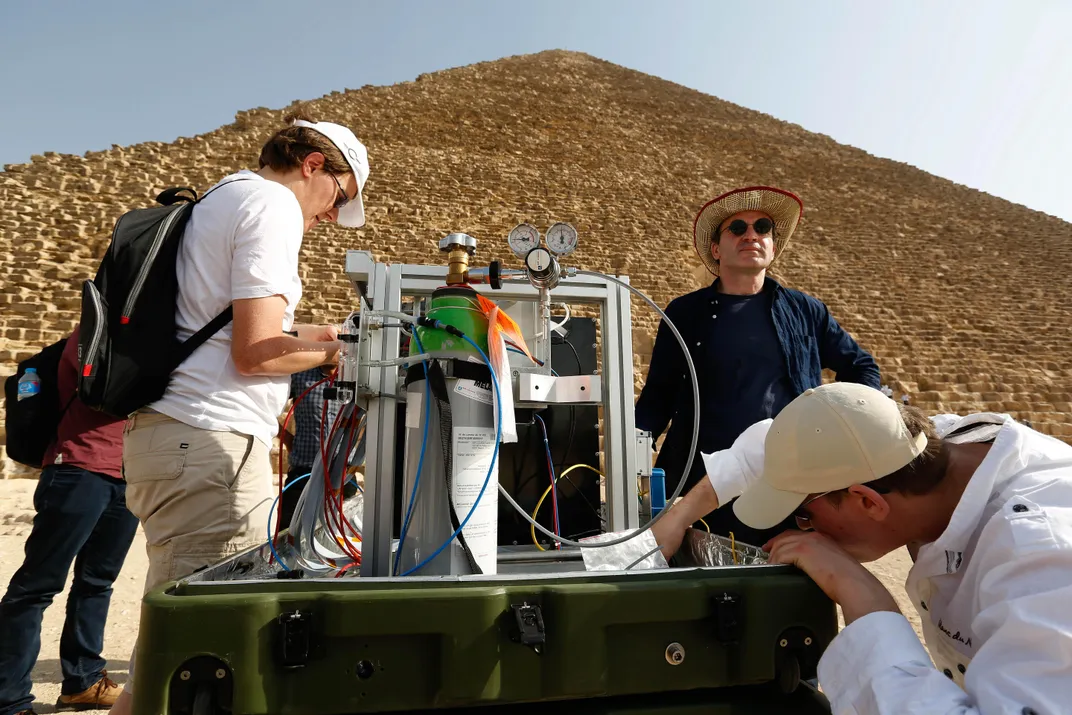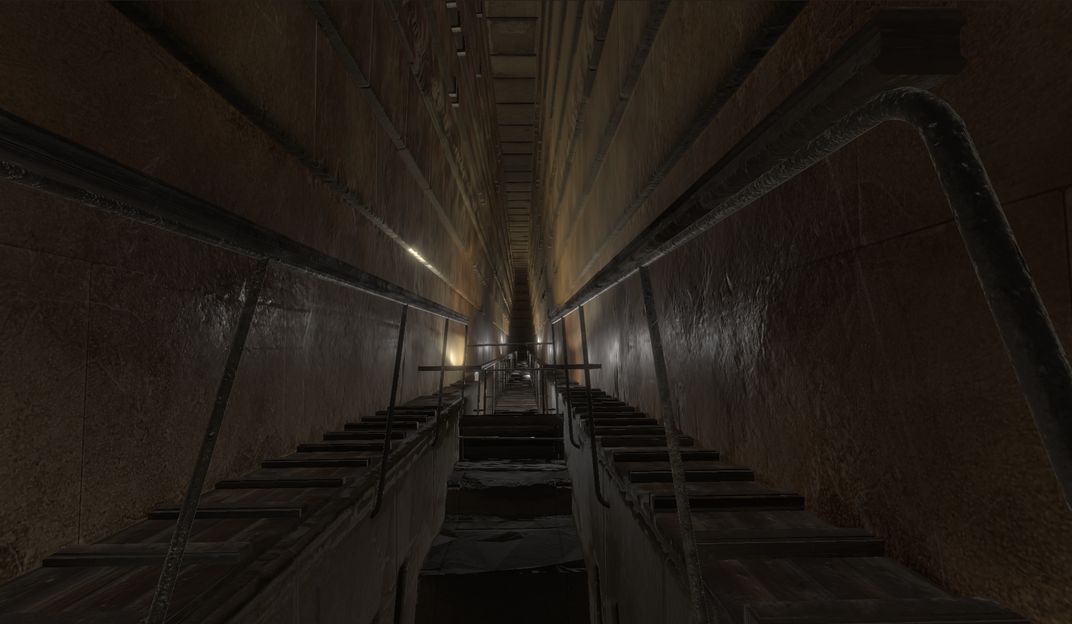How Researchers Uncovered a Massive Void in the Great Pyramid of Giza
The cavity could hold clues to how the pyramids came to be
/https://tf-cmsv2-smithsonianmag-media.s3.amazonaws.com/filer/f5/9c/f59c3254-01ca-4d51-a0e2-2631d9ba1412/2_khufus-aerial-3d-cut-view-with-scanpyramids-big-void-1.png)
Some 4,500 years ago, the Egyptian pharaoh Khufu ordered the construction of a Great Pyramid to serve as his own personal gateway to enter the afterlife. Composed of three chambers—the King's chamber, the Queen's chamber, and an underground chamber—the resulting edifice was every bit as grand as its purpose. But for centuries, rumors have swirled that the 455-foot structure harbors more hidden nooks and passageways.
Researchers first tested the idea of these secret chambers in 1986. After detecting "microgravity anomalies" near the Queen's chamber, they drilled into the adjacent corridor in hopes of discovering a secret addition. Yet no chamber was found, and later research dismissed the idea of a void—or at least, a void in that particular location.
Now new research appears to vindicate the rumors, suggesting that a massive hidden void is indeed tucked above one of the pyramid's large passageways.
To be clear, the area is unlikely to be harboring any treasure. "These voids themselves do not alter what we know about Egyptian civilization," says Mark Lehner, director of the Ancient Egypt Research Association and a member of a committee appointed to review the new findings. But they may help researchers better understand the momentous effort required to build the edifice.
The study, published this week in the journal Nature, comes from the project ScanPyramid, a multidisciplinary research team under the authority of the Egyptian Ministry of Antiquities. For several years, the team has probed the Great Pyramid using an arsenal of the latest non-destructive technologies to seek cavities hidden among the millions of stone blocks that make up the structure. These techniques include infrared analysis, 3D modeling, and a technique known as muon detection, which relies on tiny particles created from the collision of cosmic radiation and atmospheric particles.

Think of muon detection as akin to taking an X-ray. Muons travel to Earth at a constant rate, zipping through solid objects like rock. But not all of those particles make it, so you’d expect to see more muons pass through regions of lower density or voids than through solid regions. To get a good reading, researchers set up detectors to collect the scattering of muons over long periods of time, from several angles.
In the last two years, using these methods, the team has announced the existence of several possible voids, including one above the northern entrance of the pyramid and one on the eastern side. But these previous voids were relatively small, and researchers were cautious about making too much of them, since they might just turn out to be random gaps in the structure.
By contrast, the latest void is the largest and most definitive the project has yet identified. Researchers are yet unsure of the exact boundaries of the space, if it contains multiple chambers or its exact orientation to the Grand Gallery. "What we are sure about is that this big void is there, that it is impressive, that it was not expected by, as far as I know, any kind of theory," said Mehdi Tayoubi, co-founder of Heritage Innovation Preservation Institute, which runs ScanPyramids, in a Wednesday press briefing.
The first hints of the void's existence came in the spring of 2016, from muon data collected using a special photographic film that can record the paths of these particles in three dimensions. The team had set up detectors within the Queen's chamber, expecting to observe the overlying King's chamber. "Our surprise was to see a big important line parallel to the Grand Gallery," Tayoubi said in the briefing. "We understood at this time in 2016 that we had something very big and very important."
They then verified the chamber using two other types of muon detection: a gaseous detector, and an instrument that measures charged particles using a light-emitting substance. The detectors were positioned in various locations both within and outside of the pyramid, mapping out the region of interest in three dimensions.
The results define a large space that lies just above what's known as the Grand Gallery, a tall but narrow corridor that leads into the King's Chamber. The empty space they found, dubbed the "Big Void" in the paper, appears to have a similar cross section as the Grand Gallery, and is nearly 100 feet long. As of yet, the purpose of this region remains a mystery, leaving researchers cautious in describing the find. In the press briefing, they note that it should not be called a "chamber" because, as Tayoubi explains, "we don't have any architectural interpretations."

Other experts are equally cautious about interpreting the meaning of this discovery. However, this time, unlike in some past finds, they don't doubt its existence. "I believe in the anomaly that they have," says Lehner, of the Ancient Egypt Research Association. Even so, Lehner cautions that voids are common in the pyramids. Though they may look like solid structures composed of perfectly fitted blocks, "it's not the reality," he says.
The pyramid is more "Swiss cheese" than "cheddar," Lehner adds—an analogy he uses in his new book Giza and the Pyramids, which is co-authored by former Egyptian minister of antiquities Zahi Hawass, who leads the review committee. The outer casing and the passageways are often fitted stone, but the actual core of the structures can have many gaps that are often filled with "globs of mortar and small pieces of stone," says Lehner. These random gaps could be as big as 10 feet across, he says.
However, the "Big Void" is, well, bigger. "It's not a small void; it's not a big void that is filled with small and big stones," explains Hany Helal, an engineer at Cairo University and co-founder of ScanPyramids. It's a large—likely mostly empty—space.
Lehner believes the gap could be structural. "I would expect it to be some kind of weight-relieving space between the roof of the grand gallery and this mass of the pyramid core," he says.
Similarly, overtop the King's chamber lies a series of small, shallow voids capped with gabled or tented stones. This structure was intended "to distribute the stress—the weight of the pyramid above—down and away to either side, just like the tented roof on a house distributes the rain to either side," says Lehner. In their future work defining the space, he says, the discovery of tented stones above this new void would point toward a structural purpose to the space.
"That would be a ‘wow’ moment," he says.
Salima Ikram, an Egypt archaeologist at the American University in Cairo who was not part of the research, agrees that the void could help distribute weight. But, she says, it could also be an extra space necessary for workers to manipulate blocks into position. This interpretation could also explain an earlier void the ScanPyramid team found above the pyramid's northern entrance, says Lehner.
"It is very exciting that they have actually found this kind of space which really makes one start to rethink, or think more deeply, about pyramid design," says Ikram. Still, she adds, it will be challenging to get bulletproof evidence for the reasoning behind the space: "A lot of this is going to just be theoretical and we might never know."
The ScanPyramid researchers plan to continue to gather data about the mysterious space, further refining its shape and boundaries. Through innovative new technologies, the team hopes to continue to push the limits of what's possible in archaeology, says Tayoubi. They're currently working on developing tiny robots to further probe pyramid cavities—something that may not necessarily make it into practical use in the pyramid, but could be used for other historical structures.
In the press briefing, the researchers also hint at potentially more results that they are not yet ready to unveil. As Helal says: "This is not the end of the project. This is only one step among others to come."
/https://tf-cmsv2-smithsonianmag-media.s3.amazonaws.com/accounts/headshot/Wei-Haas_Maya_Headshot-v2.png)
/https://tf-cmsv2-smithsonianmag-media.s3.amazonaws.com/accounts/headshot/Wei-Haas_Maya_Headshot-v2.png)